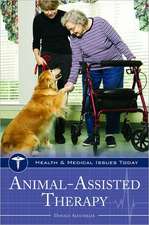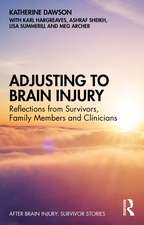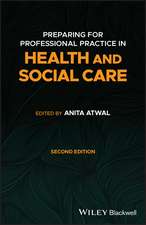International Handbook of Occupational Therapy Interventions
Editat de Ingrid Söderbacken Limba Engleză Paperback – 10 sep 2016
This Second Edition of the International Handbook of Occupational Therapy Interventions builds on its ground-breaking predecessor by modelling current clinical standards rooted in scientific evidence-based practice. Its interventions are applied to a diverse range of client disabilities, with many new or rewritten chapters on workplace and vehicle accommodations, smart home technologies, end-of-life planning, and other salient topics. New introductory chapters spotlight core competencies in the field, from assessing client needs and choosing appropriate interventions to evaluating programs and weighing priorities. And for increasededucational value, interactive case studies allow readers an extra avenue for honing clinical reasoning and decision-making skills. Of particular note is a new chapter providing a taxonomy—the Occupational Therapy Intervention Framework—and a validation study of its categories and concepts, delineating the occupational therapist’s roles and the expected outcomes.
Intervention areas featured in the Handbook include:
● Adaptive interventions, OTs manage and facilitate clients’ adaptations.
● Learning interventions, OTs teach and the clients learn or relearn.
● Enabling interventions, OTs enable clients to be meaningfully occupied.
● Preventing interventions, OTs prevent ill-health and promote clients’ ability to sustain health in daily life.
The Second Edition of the International Handbook of Occupational Therapy Interventions is career-affirming reading for all members of rehabilitation teams, including occupational and physical therapists and rehabilitation nurses. Students intending to enter this growing field and professionals working toward its continued improvement will find it useful and inspiring.
| Toate formatele și edițiile | Preț | Express |
|---|---|---|
| Paperback (1) | 940.80 lei 6-8 săpt. | |
| Springer International Publishing – 10 sep 2016 | 940.80 lei 6-8 săpt. | |
| Hardback (1) | 1452.28 lei 6-8 săpt. | |
| Springer International Publishing – 8 dec 2014 | 1452.28 lei 6-8 săpt. |
Preț: 940.80 lei
Preț vechi: 990.32 lei
-5% Nou
Puncte Express: 1411
Preț estimativ în valută:
180.02€ • 188.46$ • 148.96£
180.02€ • 188.46$ • 148.96£
Carte tipărită la comandă
Livrare economică 05-19 aprilie
Preluare comenzi: 021 569.72.76
Specificații
ISBN-13: 9783319330822
ISBN-10: 3319330829
Pagini: 948
Ilustrații: XLVIII, 900 p. 119 illus., 91 illus. in color.
Dimensiuni: 155 x 235 x 48 mm
Greutate: 1.31 kg
Ediția:Softcover reprint of the original 2nd ed. 2015
Editura: Springer International Publishing
Colecția Springer
Locul publicării:Cham, Switzerland
ISBN-10: 3319330829
Pagini: 948
Ilustrații: XLVIII, 900 p. 119 illus., 91 illus. in color.
Dimensiuni: 155 x 235 x 48 mm
Greutate: 1.31 kg
Ediția:Softcover reprint of the original 2nd ed. 2015
Editura: Springer International Publishing
Colecția Springer
Locul publicării:Cham, Switzerland
Cuprins
Part I. Occupational Therapy: Basic Information.- International Perspective on Occupational Therapy The Past – the Present – the Future.- The Genesis of International Handbook of Occupational Therapy Interventions.- Towards a Taxonomy of Occupational Therapy Interventions. A Comparative Literature Analyse of Scientific Review Articles Published 2008 – 2013.- Occupational Therapy: Emphasis on Clinical Practice.- The Clinical Reasoning Process: Cornerstone of Effective Occupational Therapy Practice.-Ethical Considerations and Priority in Occupational Therapy.- Participants in Occupational Therapy Interventions :Needs Assessments – A Necessary Phase in Rehabilitation.- Evidence-Based Occupational Therapy and Basic Elements for Conducting Assessments.- Occupational Science Informing Occupational Therapy Interventions.- Interactive Patient Cases in Occupational Therapy– How to Succeed.- PART II. INTERVENTIONS: THE OCCUPATIONAL THERAPIST MANAGES AND FACILITATES THE CLIENT’S ADAPTATIONS.- Interventions: the Occupational Therapist Manages for Adaptations ─ Overview.- Environmental Adaptation for Individuals with Functional Difficulties and Their Families in the Home and Community.- Housing Adaptations and Home Modifications.- Management of 24-Hour-Body-Positioning.- Ergonomic Interventions for Computer Users with Cumulative Trauma Disorders Glenn Goodman.- Wheelchair Seating and Pressure Mapping.- Ergonomic Considerations for Vehicle Driver-Cabin Configurations: Optimizing the Fit Between Drivers with a Disability and Motor-Vehicles.- Splints: Mobilization, Corrective Splintage and Pressure Therapy for The Acutely Injured Hand.- Splinting: Positioning, Edema and Scar Management after Burn Injury.- Wheelchair Intervention ─ Principles and Practice.- Assistive Technology Devices for Children with Disabilities.- Low Vision Intervention: Decision-Making for Acquiring and Integrating Assistive Technology.- Eye Tracking – Eye Gaze Technology.-Universal Design as a Workplace Accommodation Strategy.- Temporal Adaptation and Individuals Living with Serious Mental Illness in the Community.-PART III. INTERVENTIONS: THE OCCUPATIONAL THERAPIST TEACHES FOR THE CLIENTS’ LEARNING OR RELEARNING.- Interventions: the Occupational Therapist Teaches and the Client Learns or Re- learns – Overview.- Problem solving: A teaching and Therapeutic Tool for Older Adults And Their Families.- Teaching and Supporting Clients with Dementia and their Caregivers in Daily Functioning.- Occupational Therapy Services for Elderly with Severe Dementia.- Metacognitive Occupation-based Training in Traumatic Brain Injury.- Meta-cognitive Strategies for Training Daily Living Skills in People with Brain Damage: The Self-Regulation and Mental Imagery Program.- Teaching — Learning Strategies for Intervention with People with Neuro-visual Impairments.- Delivering Fatigue Management Education by Teleconference to People with Multiple Sclerosis.- Psycho-Educational Groups.- Illness Management Training: Transforming Elapse and Instilling Prosperity (TRIP) in an Acute Psychiatric Ward.- Psychosocial Intervention in Schizophrenia.- Intervention in Panic and Anxiety Disorders.- Redesigning Daily Occupation (ReDO) – Facilitating Return to Work among Women with Stress-related Disorders.- Trunk Restraint: Physical Intervention for Improvement of Upper Limb Motor Impairment and Function.- Constraint- Induced Movement Therapy for Restoration of Upper-Limb Function: Introduction.- Functional Electrical Stimulation Therapy: Enabling Function through Reaching and Grasping.- Joint Protection: Enabling Change in Musculoskeletal Conditions.- Cogitative Priming with Self-Speech: Implicit Memory Intervention for Improvement in Daily Motor Function in People Living with Parkinson’s Disease.- Ayres Sensory Integration® Intervention.- Upper-limb Therapy in Children Following Injection of Botulinum Neurotoxin A.- The Role of Occupational Therapists in the Rehabilitation Teamwork.- Pain Management: Multidisciplinary Back Schools and E-Health Interventions For Chronic Pain Sufferers.- Pain Management: Functional Restoration for Chronic Low-back Pain Clients.- Occupational Rehabilitation: The principles and Practice Of Work And Ergonomics.- Reintegration People Suffering from Depression into the Workplace.-Supported Employment for Individuals with Severe Mental Illness.- School-to-Work Transition Support for Youth with Disabilities.- PART IV. INTERVENTIONS: THE OCCUPATIONAL THERAPIST ENABLES FOR THE CLIENT’S RECOVERY.- Interventions the Occupational Therapist Enables the Client’s Recovery – Overview.- Using Smart Home Technology and Health Promoting Exercise.- Creating Opportunities for Participation within and Beyond Community Mental Health Services.-Intervention Program Mediated by Recreational Activities and Socialization in Groups for Clients with Alzheimer’s Disease.- Enablement In Participation in Meaningful and Essential Activities in End-Of-Life-Care.- Gardening – an occupation for recovery and wellness.- Horticultural Therapy for the Cognitive Functioning of Elderly People with Dementia.- Music as a Resource for Health and Wellbeing.- PART V.INTERVENTIONS: THE OCCUPATIONAL THERAPIST PROMOTES FOR THE CLIENTS HEALTH AND WELLNESS.- Interventions the Occupational Therapist Promotes for the Client’s Health and Wellness – Overview.- Prevention and Health Promotion in Occupational Therapy: From Concepts to Interventions.- Preventing Falls in the Elderly: Opportunities and Alternatives.- Issues Related to the Use of In-vehicle Intelligent Transport Systems by Drivers with Functional Impairments.- Work-Related Health: Organizational Factors, Risk Assessment and Well-Being.- Motivational Interviewing: Enhancing Client Motivation for Behavior Change.
Recenzii
From the book reviews:
“This handbook explains occupational therapy and the importance of evidence-based perspectives in occupational therapy intervention. … Students and occupational therapy practitioners will enjoy this book. It is of special interest to those who seek additional information about occupational therapy outside of their own practice location and country. … The editor has provided an excellent resource for students, practitioners, and researchers.” (Yvonne M. Randall, Doody’s Book Reviews, February, 2015)
“This handbook explains occupational therapy and the importance of evidence-based perspectives in occupational therapy intervention. … Students and occupational therapy practitioners will enjoy this book. It is of special interest to those who seek additional information about occupational therapy outside of their own practice location and country. … The editor has provided an excellent resource for students, practitioners, and researchers.” (Yvonne M. Randall, Doody’s Book Reviews, February, 2015)
Notă biografică
Dr. Söderback is an Associate Professor of Occupational Therapy and Rehabilitation at the Karolinska Institute, Stockholm, Sweden and University Lecturer Emerita associated to the Department of Public Health and Caring Science at Uppsala University in Sweden. She has worked for 40 years in occupational therapy, health care, and rehabilitation. She is an Associate Editor of the Journal Occupational Therapy International, and she is the coauthor of Occupational Therapy & Ergonomics.
Textul de pe ultima copertă
Advanced therapies and technologies, new service delivery methods, and care upgrades Advanced therapies and technologies, new service delivery methods, and care upgrades in underserved areas are translating into improved quality of life for millions with disabilities. Occupational therapy parallels this progress at the individual level, balancing short-term recovery and adaptation with long-term independence and well-being.
This Second Edition of the International Handbook of Occupational Therapy Interventions builds on its ground-breaking predecessor by modelling current clinical standards rooted in scientific evidence-based practice. Its interventions are applied to a diverse range of client disabilities, with many new or rewritten chapters on workplace and vehicle accommodations, smart home technologies, end-of-life planning, and other salient topics. New introductory chapters spotlight core competencies in the field, from assessing client needs and choosing appropriate interventions to evaluating programs and weighing priorities. And for increased educational value, interactive case studies allow readers an extra avenue for honing clinical reasoning and decision-making skills. Of particular note is a new chapter providing a taxonomy—the Occupational Therapy Intervention Framework—and a validation study of its categories and concepts, delineating the occupational therapist’s roles and the expected outcomes.
Intervention areas featured in the Handbook include:
This Second Edition of the International Handbook of Occupational Therapy Interventions builds on its ground-breaking predecessor by modelling current clinical standards rooted in scientific evidence-based practice. Its interventions are applied to a diverse range of client disabilities, with many new or rewritten chapters on workplace and vehicle accommodations, smart home technologies, end-of-life planning, and other salient topics. New introductory chapters spotlight core competencies in the field, from assessing client needs and choosing appropriate interventions to evaluating programs and weighing priorities. And for increased educational value, interactive case studies allow readers an extra avenue for honing clinical reasoning and decision-making skills. Of particular note is a new chapter providing a taxonomy—the Occupational Therapy Intervention Framework—and a validation study of its categories and concepts, delineating the occupational therapist’s roles and the expected outcomes.
Intervention areas featured in the Handbook include:
- Adaptive interventions, OTs manage and facilitate clients’ adaptations.
- Learning interventions, OTs teach and the clients learn or relearn.
- Enabling interventions, OTs enable clients to be meaningfully occupied.
- Preventing interventions, OTs prevent ill-health and promote clients’ ability to sustain health in daily life.
Caracteristici
Utilizes an entirely new organizational system based around intervention to increase its functionality in clinical settings First book to be structured on the goals of Occupational Therapy; patient adaptation, learning, recovery and health/wellness promotion Contains new and updated contributions from an international list of authors Includes supplementary material: sn.pub/extras
















